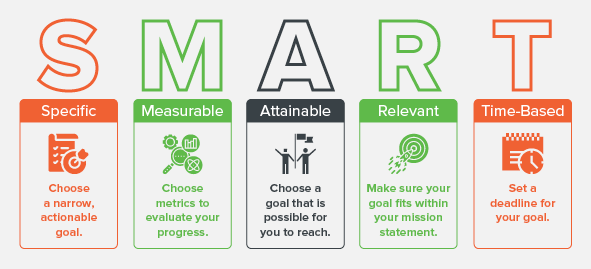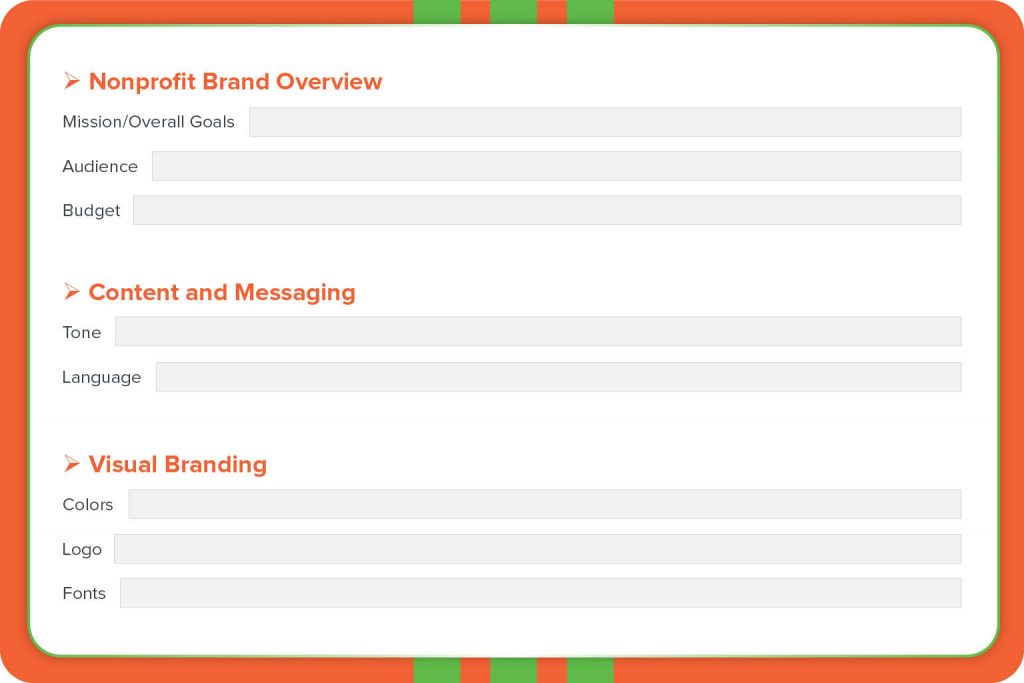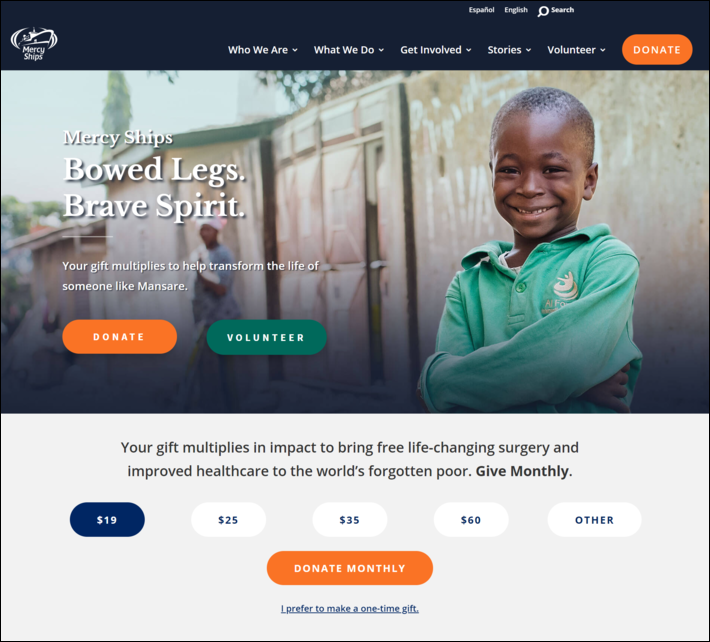To successfully market your nonprofit, you need to have a strategy. Whether you’re looking to raise more money, recruit volunteers, or just spread the word about your nonprofit, you should draft a thorough nonprofit marketing plan to help you meet your goals!
A marketing plan is a document that details the ins and outs of your marketing strategy for a specific event or campaign. Some organizations prefer to prepare these documents at the beginning of each fiscal year, and some create them as individual campaigns come up.
Here at Qgiv, we provide online fundraising solutions for nonprofit organizations. One of the most important steps your nonprofit can take before running a fundraiser is to create a thorough marketing plan that will set you up for success… because “if you build it, they will come” just doesn’t cut it when it comes to fundraising! We have the tips and tricks you’ll need to make your marketing plan a useful tool for your entire team.
If you’ve never created a marketing plan before or need a refresher, look no further! This nonprofit marketing guide will cover the following topics:
- The Importance of Creating a Marketing Plan
- Nonprofit Marketing Plan Basics
- Nonprofit Marketing Plan: Channels to Promote Your Nonprofit
Let’s start by establishing why it’s so important to focus on creating an effective marketing plan.
See how Qgiv can help you with your fundraising campaign! Request Demo
The Importance of Creating a Marketing Plan
Why is it so important to create a marketing plan for your nonprofit?
Reason #1: To Focus Your Team on Increasing Reach and Community Awareness
Marketing helps you spread your message far and wide and invite supporters to donate to your cause, participate in events, and volunteer. It also gives you the opportunity to connect with people who might be interested in your cause and haven’t heard about it yet. This means your marketing activities—especially on your website and on your social media channels—should be thoroughly planned so you give yourself the best chance of establishing your nonprofit as a legitimate organization to people who are vetting you before making a gift.
The increased engagement from current supporters and interest gained from new supporters can help you bring in more donations. And when you have more revenue to work with, your organization’s capacity to accomplish your mission is increased.
Reason #2: Provide Important Information, Clarification, and Organization for Your Team
A nonprofit marketing plan requires you to think through your marketing goals, your audience’s communication needs, your organization’s brand, your budget, marketing channels you want to use, and what roles your team members play in your marketing strategy.
Determining each of these components can provide valuable clarification and insight for your team as you prepare for a specific fundraiser or general marketing push.
This means good marketing should allow you to:
- Take a critical look at your marketing strengths and weaknesses
- Evaluate your progress toward you current goals
- Set new goals based on your progress
- Clarify and help you connect with your target audience
Thinking through your marketing strategy also provides the chance to evaluate your standing in your sector. During the research and planning phase, you’re able to evaluate your nonprofit’s position compared to similar organizations. As you plan, ask yourself the following questions:
- What ways can you help the community that aren’t possible with other organizations?
- What can you do to help your nonprofit stand out from the competition?
- How can your marketing help set you apart from other groups that are doing similar work?
Creating a nonprofit marketing plan is beneficial to your specific marketing campaigns and can also help your organization evaluate your nonprofit and assess areas in which you stand out from the crowd.
Now that you understand the importance of creating a marketing plan for your organization, let’s walk through the fundamentals of creating your plan.
Nonprofit Marketing Plan Basics
As you read through this section, remember that each of these steps should be adapted to fit your specific organization’s needs. Not every nonprofit is the same, and you know your audience best! Make sure you’re keeping your mission, audience, and goals in mind each step of the way.
Determine Your Goal
Without setting a specific goal for your marketing campaign, you’re more likely to lose sight of what you want to accomplish with your marketing campaign. It’s easier to get sidetracked, and it’s harder to stay on topic as you share content across your different marketing channels.
We recommend you begin your goal setting by taking a look at a previous year’s data for a similar campaign or event. A data reporting tool like Qgiv’s data package can be especially helpful in this situation. It can make the task of interpreting data much easier for your team, which will save you time and effort that could be used elsewhere.
Once you’ve identified trends in your data, you can move forward with setting a goal. Use the SMART acronym to set a goal your organization can actually achieve:
- Specific: Create a definite goal. Don’t try to do too many things at once. You’ll be setting yourself up for disappointment.
- Measurable: Decide on what metrics you’ll use to assess how you’re progressing toward your goal. This information will help you adjust your strategy if you need to.
- Attainable: Make sure your goal is possible! For example, a goal to jump from 200 Instagram followers to 250 Instagram followers may be more attainable than a goal to jump from 200 to 2,000 followers.
- Relevant: Align your goals with your cause and your mission statement. Don’t let the big picture get away from you! If you’re an animal shelter, your goal to send flowers to hospital patients is probably not appropriate. Choose a different goal!
- Time-based: Set a clear date for when you want to meet your goal. Even if you don’t meet your goal by that day or time, you’ll still be setting yourself up to take a moment to reassess and re-evaluate your goal.
Let’s walk through an example of a SMART goal. Say your nonprofit notices that your monthly giving program has a low enrollment rate. You decide to focus on marketing the program and set a SMART goal. You might write out your goal on your marketing plan like this:
“Over the next six months (time-based), we will increase our monthly giving program enrollment from 45 donors to 75 donors (specific and attainable). We will measure our progress by checking our enrollment numbers weekly (measurable) and will strive to market the program as a way donors can help us consistently provide hygiene kits to refugee families in need (relevant).”
A SMART goal like this can serve as a guiding star for your marketing plan, creating a touchpoint you can return to again and again to see whether or not your marketing plan is working effectively.
Determine Your Audience
Your marketing plan should target a specific audience. You might decide to aim for current or previous supporters, potential new supporters, or to reach out to a new group that would be interested in your cause and helpful to your mission.
Once you know what audience you’re aiming for, we recommend you segment your existing audience. This essentially means that you divide your audience into groups based on similar traits or characteristics. You might sort your audience by age, gender, giving preference, giving history, or donation type.
Another strategy you could embrace is creating a donor persona. A donor persona is a semi-fictional person made up of the traits of your chosen audience or donor segment that can guide you in your marketing efforts. This gives you someone specific to picture as you plan your marketing.
Here’s an example. Depending on your cause, you might picture an upper-class, middle-aged businesswoman or a young father with school-aged children. The more details you create for your persona, the easier time you’ll have stepping into your donors’ shoes and planning your marketing campaign around their needs and interests.
Determine Your Audience’s Preferred Methods of Contact
Once you understand the audience you’re marketing to, the next step is to figure out the best way to connect with them. It’s no secret that different demographics respond differently to different marketing methods, so plan accordingly!
For instance, take a look at this information to get an idea of what different donors might prefer:
- Social media: According to our research, social media posts were the top drivers of charitable giving for our respondents in 2020. Our data also shows that your site and social media accounts are the first two places donors go for updates. In terms of which demographics use which social media channel, Pew Research Center reports, for example, that of American adults aged 30-49, 77% use Facebook, 48% use Instagram, and 27% use X.
- Direct mail: Our Generational Giving Report shows that direct mail appeals are most successful with Baby Boomers. Almost 50% of these donors prefer to give using a physical check instead of an online platform. That doesn’t mean they’re the only age group that should receive direct mail; many Generation X, Millennial, and even Generation Z donors appreciate direct mail updates, even though they’re more likely to go online to give. Curious about their preferences? Try sending a survey!
- Text fundraising: Our research shows that Millennials are the group most likely to give via text message or through an app, while 29% of Gen X donors prefer to give via text.
This information should get you thinking about how your donors want to communicate with you and how they prefer to give.
But remember: While it’s useful to look at information from a reliable outside source (such as Qgiv), you also have a wealth of telling data that’s specific to your organization. Your base of supporters is unique! Make sure you get to know your audience’s needs and preferences so you can choose the marketing methods that will be most worth your while.
Create a Style Guide for Consistent Branding
If you don’t already have one, take time in the planning process to create a style guide that can inform all of your marketing materials’ branding. Keeping both your print and digital branding consistent with each other makes it easy for supporters to remember your organization and will help you build a positive reputation with the general public.
On the other hand, inconsistent branding can make your organization appear disorganized and unprofessional. For example, if you use vastly different imagery and colors for your fundraising letters as compared to your social media posts, you can easily confuse your supporters and leave them wondering if you’re a reliable organization. Donors want to know that the organizations they support are trustworthy and reputable!
Want to fill out your own nonprofit marketing style guide? Download our template!
Put Together a Promotions Budget
It’s no secret that nonprofit organizations have to make every dollar count. As you prepare to select what marketing channels to use for your campaign, it’s important that you set your budget carefully. Doing this will help you decide which marketing channels will provide the greatest return on your investment.
Remember to be as specific as you can about the expected revenue and results of your campaign, as well as the expenses your organization will incur as you put your plan into action.
Pro tip: Don’t forget to allow plenty of time to get board approval on your marketing budget!
Choose Your Avenues for Promotion
Once you’ve set a clear goal, feel like you truly understand what your donors need from you, and have a good grasp on your budget, it’s time to choose the marketing channels you’ll use during your campaign.
For example, you may determine that the best way to get the word out about your upcoming dance-a-thon is to run a few catchy radio ads, send direct mail appeals, and create and share blog posts.
However, keep this in mind: To set yourself up for success, you should determine who you’re targeting and what resources you have at your disposal before picking your marketing channels.
Give Your Team Members Specific Roles
Each member of your team should have specific tasks and roles outlined in the marketing plan that will help them do their job effectively. Your marketing plan should be a one-stop location for your team to find answers to questions about the plan and what tasks they’re responsible for. Be as clear as possible about each person’s role, responsibilities, and deadlines.
Put Your Plan into Action
After you create a solid marketing plan, you should be able to use it to guide your team during the entire campaign. Refer to your document often to make sure you’re meeting deadlines, staying on track with your goals, and sticking to your budget. Your marketing plan will help keep your team organized as you wade into the intricacies of your marketing and fundraising campaigns.
Evaluate Results for Next Year
As you work through your marketing plan, take the opportunity to collect useful data you can use to inform future marketing campaigns.
Based on your campaign, the data you track will vary a little. We suggest you track the following:
- High and low points of the campaign (What went well? What didn’t go well?)
- How successful you are in accomplishing your goal (What contributed to your success or shortfall?)
- What marketing channels were most effective
- How team members contributed to your success and what they can do in the future to be even more succesful
We also suggest you survey your audience! Create a short online survey and make it an optional activity at your fundraising event or add it to your donation form’s confirmation page. Don’t be afraid to ask for feedback about what marketing strategies worked best for them and what they would like to see more or less of in the future. Done well, a survey can be an invaluable way to get insight into what inspires and motivates your donors.
Nonprofit Marketing Plan: Channels to Promote Your Nonprofit
In this section, we’ll take a closer look at different marketing channels and how you can use them to connect with your audience. Keep your donor segments and persona in mind as you consider each of these options. They will help you find the best channels for your marketing plan.
See how Qgiv can help you with your fundraising campaign! Request Demo
Your Organization’s Website
Your website is the home base for your nonprofit’s online presence. As a marketing tool, your website should provide your supporters with all the information they need to donate online, RSVP to events, and otherwise participate in your fundraising campaign.
To optimize your website for marketing purposes, you need to focus on your site’s design and user experience. What does a supporter see and feel when they visit your website? How easy and intuitive is it for your supporter to find the information and resources they need?
Keeping these questions in mind, here are some elements you could include on your website to help you market your cause or a specific campaign or event:
- An intuitive navigation menu: A navigation bar or menu can help you organize each of your web pages under different categories, making valuable resources easier and faster to find. Try taking a top-down approach to creating your navigation menu. This means you should provide links to the most important sections of your website first.
Pro tip: Facilitate donations by making your “Donate” button easy to find! Make your button a color that contrasts (but complements) the color scheme for the rest of the navigation item, and make it a standalone button. Potential donors should be able to get to your donation form in a single click. - A hero image: First impressions are everything! What a visitor sees on your homepage will leave a lasting impression of your brand and what your organization stands for. A hero image is an oversized banner image that lets you showcase one striking image.
- Striking visuals and graphics: When you pick images or design graphics for your website, make sure they reflect what your organization is all about. You can use graphics software to create clean visual designs and apply your organization’s branding to the images you choose. Your visuals should help drive an emotional connection between your website and your site visitors. For example, the header image on the Mercy Ships homepage is a picture a young boy who received a life-changing surgery. Any visitor to the site immediately feels a connection to the organization’s mission to medical care to the world’s poor.
There’s a ton of advice out there about designing your nonprofit’s website effectively. Check out Qgiv’s tips on donation page design to get a better sense of the options available to you as you design your website.
Once you create a website that’s memorable and user friendly, you can use it to effectively promote events and campaigns by posting regularly on your blog, adding a live social media feed on your homepage, and creating dedicated pages or microsites for particular events and campaigns.
Word of Mouth
One of your greatest marketing assets is your current base of supporters. After all, they already care a lot about your cause! That means they’re likely willing to help you spread awareness about upcoming events or campaigns. Word-of-mouth marketing can be tricky to organize, but it often has no (or low) costs associated with it! This kind of marketing also lends credibility to your organization and makes other people more likely to trust and invest in your nonprofit.
When you ask your volunteers, staff members, donors, and other supporters to share information about your nonprofit or your programming with their networks, it may be useful to give them some basic talking points they can use. Make sure to include these elements: your nonprofit’s goal/mission, the community your nonprofit serves, and the actions your nonprofit takes to serve that community.
Going off of this template, your talking points might look like one of the following:
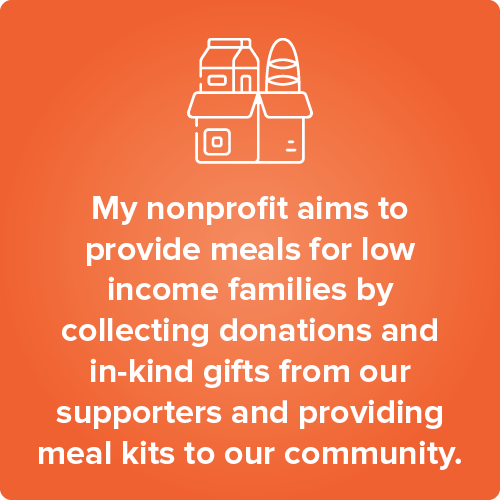
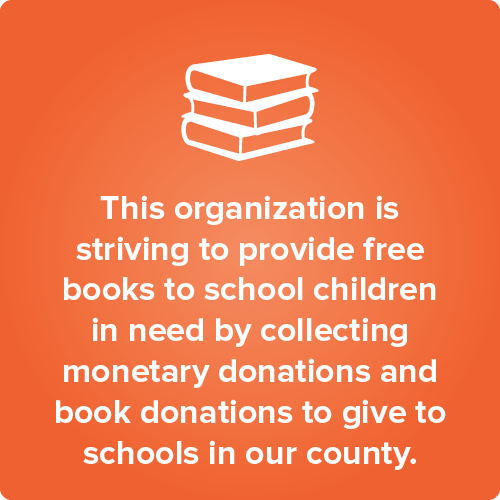
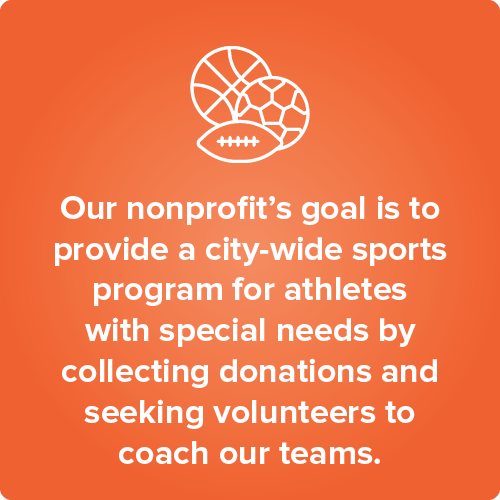
Here are some other ways your supporters can implement word-of-mouth fundraising:
- Create graphics your supporters can use to promote your campaign and share information. For example, try creating a frame for your supporters’ Facebook profile pictures, a flyer they can hang in their break rooms at work, or postcards they can pass along to friends, family, and neighbors.
- Ask your organization’s sponsors to help promote your event. Give your sponsors flyers and posters to hang in their place of business. Remember to include information about their sponsorship on the poster to let people know how they’re connected to you and to give your sponsor’s reputation a little boost within your community.
- Leverage your local connections and find creative ways to promote your fundraising efforts. If your sponsor is a local retail business, you might ask if they would be willing to put small postcards promoting your monthly giving program in customers’ bags after they purchase a product. If your event is going to take place at a local restaurant, ask if you can put tables or tents outside where your volunteers can advertise the event.
Direct Mail
Direct mail is its own special kind of print marketing. According to this direct mail guide for nonprofits, direct mail continues to be the greatest source for donations to U.S. nonprofits year after year.
For a direct mail campaign, you might use the following:
- Fundraising letters
- Fundraising postcards
- Brochures
- Fundraising packets (for major donors)
Because most of the mail we get every day is bills or grocery store coupons, getting direct mail from a beloved nonprofit can be a unique experience for a supporter. A tangible reminder of a cause they’re passionate about can often motivate a supporter to give, register for an event, or sign up with a volunteer program.
When preparing your direct mail materials, remember to personalize them as much as you can. Don’t forget to make sure the branding of your direct mail campaign matches your online marketing materials. You can often connect the channels by including a QR code, links to social media profiles, or text keywords!
Emails are a great marketing tool because they don’t take a lot of time or money to send. But that doesn’t mean you should send them without any thought or strategy! Here are a few email marketing suggestions specifically for nonprofits:
- Save-the-date emails: This type of email could be a complete save the date or a fun “hype” email announcing that something big and exciting is coming. Both types of email can then be followed up with a more formal invitation. For example, here is how the Pet Alliance of Greater Orlando used save-the-date emails for their upcoming 2021 Furball:
- Discount emails: Give your supporters the feeling that they’re part of an exclusive club! Create an email that offers early event registration, promo codes, or gift matching information for donations completed completed by a certain date during your campaign.
- Sponsorship and speaker/entertainment announcements: Send an email letting event attendees know who will be performing or speaking at your event to get them excited about attending. You can also make your sponsors happy by announcing their participation in the same email.
- Auction and raffle item teasers: Get people excited about attending your event by showcasing some of the items they could win. This is a great opportunity to promote big-ticket items, sell raffle tickets, and encourage registration.
- Registration confirmation emails: Don’t send a generic confirmation email when someone registers for an event. Instead, use this email as an opportunity to drum up excitement for your event. You can also encourage further outreach by making it easy for registrants to invite their friends by offering an invitation form and including social sharing options.
- Event agenda email: This should serve as a follow-up to a save-the-date that gives more details and reminds people to register.
- Pre-event email: Include reminders on parking instructions, start times, check-in protocol, and other key information. If you’re using an app like Givi for your event, encourage your users to download it in advance by including a link.
- Post-event surveys: Seek feedback from your attendees that you can incorporate into your marketing plans and fundraising events in the future. This signals to your supporters that you care about the experiences they have with your organization.
- Appeal emails: Emails are useful for more than events! Send emails to your donor base that show them a problem and invite them to be part of the solution by donating.
- Impact updates: Donors like to know that their money is used wisely after they support your nonprofit. Keep donors connected to your work (and set the stage for future appeals) by sending periodic updates about what they’ve helped accomplish with their past support.
To know what kinds of emails will work best for your audience, remember to rely on segmentation and donor personas!
Text Message Marketing
Text message marketing is highly effective because of text messages’ 98% open rate.
Use text marketing to announce events, send urgent appeals (remember to include instructions for donating!), remind volunteers about upcoming shifts or training, and promote donations throughout your campaign or specific event. You can do this with your text-to-give or text-to-donate tool.
You can even collect donations during an event with text fundraising! Use your text messaging tool to send texts to attendees letting them know they can give right from their phones. Further promote giving with a public Fundraising Hub displaying a live fundraising thermometer.
If you’re hosting an auction, use your auction bidding platform to send push notifications to your event attendees. Share information about closing bid times, hype up big-ticket items, and promote items that may have been overlooked during the excitement. Push notifications keep auction guests in the loop and let them know when bidding starts and ends. They’re also a great way to alert people when they’ve been outbid on an item, which increases the number of bids placed at an event. More bids mean more money!
Other Print Materials
There always seems to be a rumor that print marketing is old-fashioned or even dead. But that’s just not the case. Print materials, especially when used in conjunction with digital marketing, are a great way to get your messaging out there for the world to see.
There are three types of print materials:
- Flyers: Flyers are meant to be distributed widely and are usually the size of a standard sheet of paper or even smaller. They’re usually handed out in a public place or sent through the mail.
- Posters: Posters are larger print materials that you can hang in a public place. They should be well-designed and include strong visuals and clear information about your fundraising campaign or event.
- Banners: Banners allow you to catch the eye of a large audience. These are oversized print materials typically hung on the side of a building with a short and sweet promotional message.
One of the most valuable ways to use print materials is to ask local businesses to display them or station volunteers outside their buildings to hand out flyers.
This is a great way to involve your sponsors, too. You might even consider asking a local printing or graphic design company to sponsor your campaign by donating your print materials! Whatever way you decide to get your sponsors involved in creating or distributing your print materials, make sure to have a section on your print materials for your sponsor’s logos so they get some advertising, too.
Press Release
A press release is a short, informative article sent to the news media that announces an organization’s event, campaign, or other notable updates. Media representatives then use the press release to write a news report about your organization’s announcement.
Press releases are typically written by a public relations professional, but you and your team can easily create one by following these steps:
- Put the most important information at the top of the press release. For an event, for example, you you’ll want to include the date, time, and purpose of your event.
- Include a few quotes from leaders in your organization. You might ask for a statement about your campaign or event from a board member or your executive director. This will give members of the media something to use to better flesh out the story about your campaign.
- Offer additional information about your organization. Offer a link to your website and include your logo or slogan on the press release in case the media wants to learn more about your mission.
- Keep it short and break long paragraphs into bulleted lists. Press releases should be easily skimmable. Make sure your reader learns the most important information without losing interest.
When writing your press release, return to your marketing plan and look over the SMART goal you set as an organization. This will guide you as you write your press release and work to keep the announcement connected to your overall cause.
Paid Online Advertising
Another effective marketing avenue is paid digital advertising. You run paid ads through platforms like Google AdWords, Facebook, or LinkedIn. Many organizations go for a pay-per-click (PPC) option, which means you only pay for your ad when people click on it.
PPC ads rely on keywords, and that means some ads will be more effective than others. That said, you’ll want to be intentional about the keywords you choose. Ads that contain keywords that are in high demand can be expensive! For example, the keyword “fundraising auction” will be much more expensive than a keyword that uses your organization’s name, and it may be harder to get a ton of attention because many others are using the same keyword. As you plan for PPC ads, be realistic about what keywords you want to vie for in the digital space.
PPC advertising is also a great way to track what is effective for your audience. Experiment with different versions of your ad and different keywords to see what gets the most clicks. These insights will help you with future marketing plans, too.
Social Media
Social media marketing is a great tool that can help you reach new audience members. But remember: Different demographics gravitate toward different social media channels! TikTok, for example, is a platform that typically appeals to a much younger audience than Facebook does. If you’re trying to reach well-established individuals who would attend formal events, TikTok is probably not the best channel to prioritize.
If you want to be successful on social media, you’ll need to evaluate where your audience is. Look into these popular social media platforms:
- YouTube
- X
- Snapchat
- TikTok
Each of these platforms has different best practices and content types. For example, Instagram content is mostly focused on visuals. X users, on the other hand, usually share short updates made up of 280 typed characters (or less).
You’ll also want to be strategic about when you plan to publish your content. If you use the right social media campaign tools, you’ll be able to schedule posts to be published at specific times and on specific days. Pay attention to when you get the most activity from your supporters on different social media platforms and schedule important posts for those times.
See how Qgiv can help you with your fundraising campaign! Request Demo
Final Thoughts
Marketing is a crucial part of any successful nonprofit fundraising campaign or event. To make sure your marketing is effective, you need to outline a clear plan that everyone on your team can follow.
If you follow the steps in this nonprofit marketing guide, you’ll create a thorough plan that can set you up for fundraising success.
Interested in learning more about marketing? Check out these additional resources:
- Tailor Nonprofit Email Marketing to New and Existing Donors. Read this article to learn more about segmenting your support base so your email outreach efforts are more effective.
- How to Promote a Fundraiser Like a Pro Looking for even more ways to master the art of nonprofit promotion? Check out this list of ideas.
Want help marketing and planning your next event? Download one of our Qgiv event planners:


